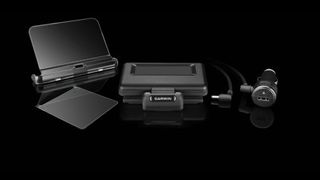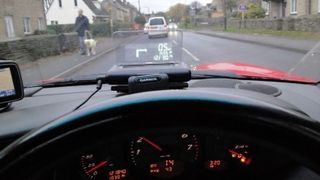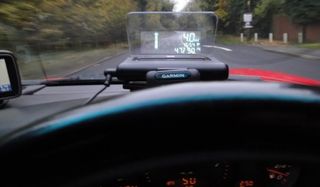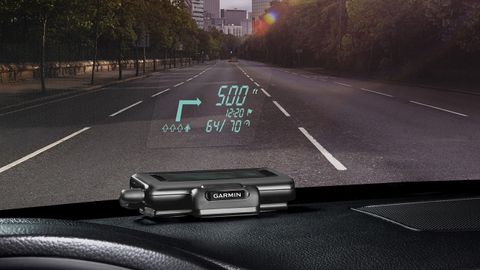TechRadar Verdict
A very effective way to add head-up display capability to your car, but adds to in-car clutter
Pros
- +
Compatible with almost any car
- +
Head-up display works well
- +
Easy to set up and use
Cons
- -
Adds to in-car cable clutter
- -
Looks very 'after market'
- -
Requires smartphone app for functionality
Why you can trust TechRadar
One day, car technology might put an end to just about all road accidents.
But right now we're in a tricky phase where drivers are being bombarded with more and more features and functions.
That's a major problem when it comes to driver distraction. It's never a good idea for to take your eyes off the road ahead, even to glance momentarily at your navigation screen. That's exactly where the new Garmin HUD comes in.
It's a head-up display that's compatible with literally any car, no matter how new nor how old. The idea is that is delivers heads-up navigation cues along with other information including your current speed and time to destination so that you can keep your eyes forward and on the road.
Garmin HUD: How does it work?
So, how does it all work and is it any good? The first part of the how does it work bit involves the unit itself. It's a little black tablet the size of a small smartphone, albeit much thicker.
It's actually a hinged two-part device. The bottom slice is flexible and has a sticky pad, which together allows the whole thing to be mounted on most dashboards. It also has a pair of screw holes so you have the option of a semi-permanent installation if preferred.

The top half has the multi-function display, which is actually a pretty old school monotone vacuum fluorescent affair with a fixed array of functions and icons rather a pixel grid.
In simple terms, you mount the unit on your dash pretty much directly ahead of your eye line and allow the display to reflect onto your windscreen. Garmin provides a transparent reflective patch you can optionally attach to you windscreen to improve contrast. For most cars, that's probably the way to go.
Setup
You'll have to experiment a bit to get an ideal position but it's not actually a difficult task. However, for some cars, depending on the dash design and the angle of the windscreen, that may not be workable. So Garmin also provides a little flip-up screen that allows the head-up functionality to work without using your windscreen.
The bottom line is that it's very likely you'll be able to come up with a workable solution in terms of viewing the head-up display. That said, it's not a hugely elegant solution.

For starters, it requires a power cable which creates in-car cable mess. You could have a USB power cable professionally installed which would largely mitigate that problem. But you'll still be left with a rather odd-looking lump sitting on your dash.
Pretty it ain't. In short, for neatness and slickness, there's no substitute for a factory-fitted head-up display.
Smartphone compatibility
The other part of the setup equation is syncing with a compatible smartphone. That's necessary because the Garmin HUD doesn't have any nav or GPS capabilities of its own. It's essentially a Bluetooth-powered display.
You'll need a compatible navigation app installed on your smartphone, either Garmin StreetPilot app (iOS) or the Navigon App (iOS, Android, Windows Phone). Then you simply sync the two device via Bluetooth, at which point your handset will prompt you to choose a compatible app from a list (any compatible nav apps you have installed are highlighted) and that's really it.

From then on, you really don't have to touch the Garmin HUD again. Instead, it all happens on your handset. You hop into the relevant nav app and set a new destination as you normally would and the rest works automatically.
For starters that means visual navigation cues including a lane indicator, graphics depicting what exit to take off a roundabout, estimated time to destination the usual stuff. You can also see both your speed and the local speed.
Depending on the nav app your using and the features you have installed on your handset, the HUD also supports speed camera warnings.
Performance
So it's pretty easy to set up and works seamlessly thereafter. But is it actually any good? The answer is mixed.
In terms of legibility, it's a win. The 'head-up' part of the proposition really works. If you've never experienced a head-up display before, the Garmin HUD will quickly convert you to the basic idea.

As for the accuracy of the mapping, that's obviously down to the nav app you're using, though obviously you are limited to Garmin and its sister outfit Navigon. If, say, you're a TomTom devotee, that could be a problem.
Verdict
From there on, the appeal somewhat dwindles. As we mentioned, it's not a terribly tidy looking solution. It's always going to look a bit 'stuck on'.
With navigation cues essentially limited to arrows on a small monotone screen, it can be difficult to follow direction cues at times, too. Sometimes it helps to have a full graphical map to glance at when approaching a complex junction.
Of course, you can have that in parallel with the HUD via your smartphone sitting in a cradle. But that means another device sprouting from the dashboard, more cables, more clutter.
Ultimately, what you make of the Garmin HUD will hinge on how fastidious you are about slick integration and keeping you car looking tidy and unmodified. The HUD delivers on most of Garmin's claims, but you'll never forget it's an aftermarket device.
Technology and cars. Increasingly the twain shall meet. Which is handy, because Jeremy (Twitter) is addicted to both. Long-time tech journalist, former editor of iCar magazine and incumbent car guru for T3 magazine, Jeremy reckons in-car technology is about to go thermonuclear. No, not exploding cars. That would be silly. And dangerous. But rather an explosive period of unprecedented innovation. Enjoy the ride.

Scientists inch closer to holy grail of memory breakthrough — producing tech that combines NAND and RAM features could be much cheaper to produce and consume far less power

Google adds biometric verification to Play Store to keep your in-store wallet safe

Quordle today – hints and answers for Wednesday, April 17 (game #814)
